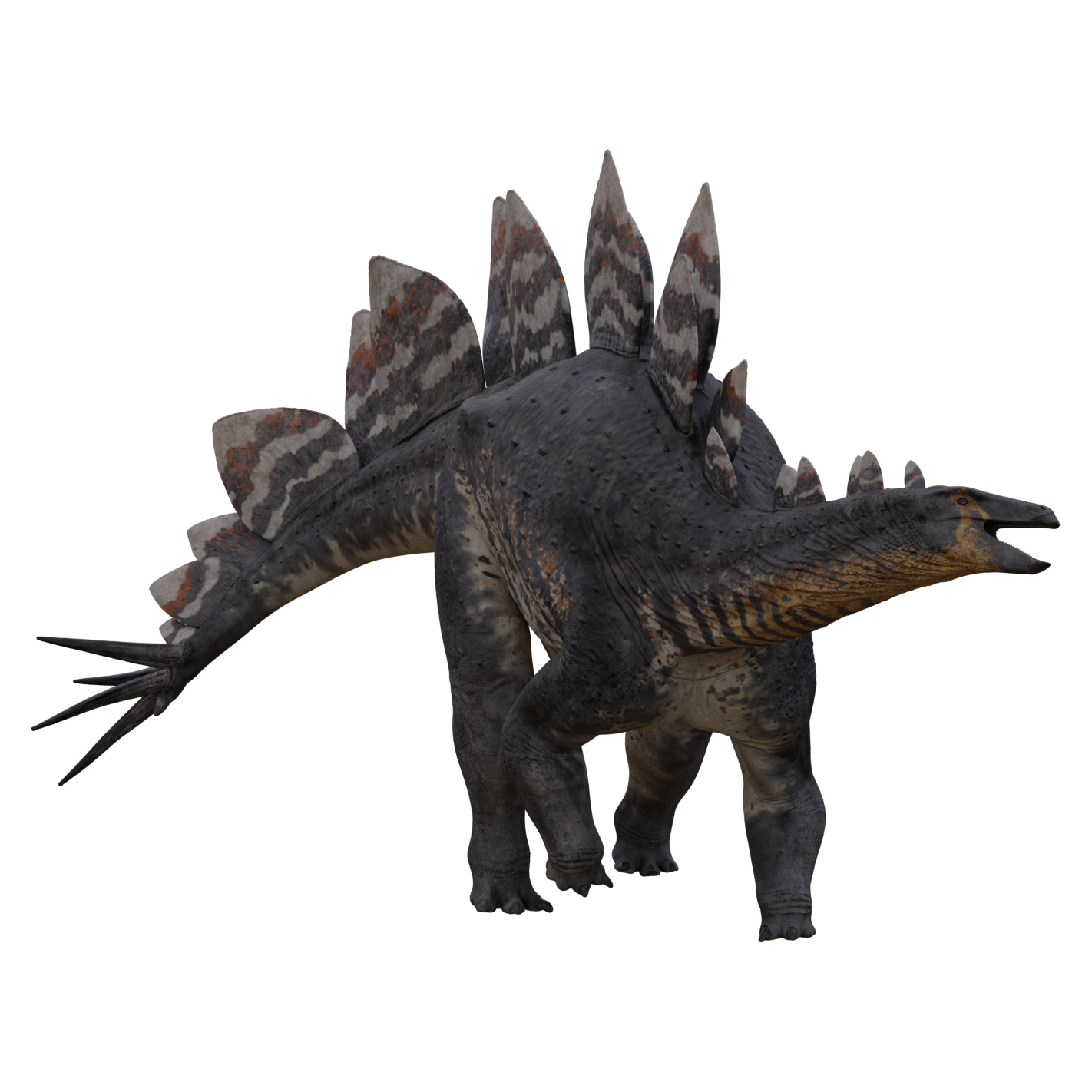The Jurassic Gladiator
With a zig-zag row of plates down its back, this iconic dinosaur could impress and intimidate, but it wasn't all show, for it also had a set of tail spikes that it would have used to great effect against predators like Allosaurus.
Overview: One of the most iconic dinosaurs of the Late Jurassic Morrison Formation of western North America is Stegosaurus, discovered in the late 19th Century by O.C. Marsh. One of the last, largest, and best-known of its kind, Stegosaurus is the quintessential stegosaur. With a zig-zag row of large, probably colorful plates running down its back, Stegosaurus was probably the biggest show-off of the Morrison. This flashy herbivore also came armed with a set of tail spikes that it would have used to great effect against predators like Allosaurus.
Discovery: The first specimen of Stegosaurus was found near Morrison, Colorado by Arthur Lakes in the latter part of the 19th Century and described by Othniel Charles Marsh in 1877. The specimen (YPM 1850) was fragmentary, but included one of the dorsal plates, which inspired its name, Stegosaurus armatus, Stegosaurus meaning “roofed lizard”, and “armatus” meaning “armored, because Marsh thought the dorsal plates were armor which lay flat on the animal and overlapped like shingles on a roof. A second species of Stegosaurus, S. ungulatus, was discovered at Como Bluff, Wyoming and named by Marsh in 1879. A third species, S. stenops, with a species name meaning “narrow faced”, was discovered and collected by Marshall Felch at Garden Park, near Cañon City, Colorado, in 1886, and named by Marsh in 1887. A fourth species was named by Marsh, also in 1887, called S. sulcatus, meaning “furrowed”, which is notably different from other Stegosaurus species and may not be Stegosaurus at all, but a different type of stegosaur. While S. armatus was the original species and therefore the “type” species, it was found that the specimen it was based on was too fragmentary and undiagnostic to be valid, so the ICZN (International Code of Zoological Nomenclature) decided to declare S. armatus a nomen dubium (dubious taxon) and make the much better-known S. stenops the type species for the genus Stegosaurus. S. stenops is now known from over 50 individuals, both adults and juveniles, including at least one complete and articulated skeleton, numerous partial skeletons, and a few skulls. It has also been suggested the S. ungulatus may actually be just large members of S. stenops, though this is not universally accepted.
Evolution and Description: Stegosaurus was an ornithischian (“bird hipped” dinosaurs), and a member of the clade Thyreophora, a group of quadrupedal ornithischians that generally had small heads and armor and included the sub-clades Stegosauria and Ankylosauria. Unsurprisingly, Stegosaurus was part of the former, in the family Stegosauridae. Stegosaurs typically had stocky builds, large bodies, small heads, and plates and spikes running along the backbone. Such was the case with Stegosaurus. Stegosaurus was one of the largest stegosaurs. S. stenops grew 6.5 m (21.3 ft) in length and up to 3.5 metric tons (3.9 short tons) in weight. If the larger S. undulatus is found to be synonymous with S. stenops, then that would increase the maximum known size of S. stenops to 7-7.5 m (23-25 ft) in length and 3.8-5.3 tonnes (4.2-5.8 tons) in weight. The tail of Stegosaurus was held rather high off the ground, while its head would have been held only about a meter off the ground. Stegosaurus’s head was small, containing the proportionally smallest brain of any dinosaur, only about 80 g (2.8 oz). It may have had a blunt turtle-like beak at the end of its snout and may have also had fleshy cheeks which would have helped it chew its food. Stegosaurus’s 17-22 plates, which were highly modified osteoderms (boney armored plates in the skin), were arranged in a staggered double row or zig-zag pattern from the animal’s neck to its tail. The largest of these plates, positioned over the hips, could measure more than 60 cm (24 in) wide and 60 cm (24 in) tall. The end of its tail featured a thagomizer, a set of tail spikes (four in Stegosaurus), also modified osteoderms. These spikes grew to be 60–90 cm (2.0–3.0 ft) long, and would have had a keratin covering in life, making them even longer and sharper. Unlike most other dinosaurs, Stegosaurus growth slow growth rates, along with chemical analysis, suggest that it may have been cold-blooded, or at least ran a cooler than other dinosaurs.
Behavior and Ecology: Stegosaurus lived 155-145 million years ago during the Late Jurassic Period in western North America in the environment that would become the Morrison Formation. This was probably a warm semi-arid floodplain with strong seasonal rainfall. Much of it was covered in fern savanna, while gallery forests of tree ferns, ginkgoes, conifers, and cycads grew near permanent water sources such as lakes and rivers. Inhabiting this environment were numerous herbivores including the giant sauropods like Supersaurus, Brachiosaurus, Apatosaurus, Barosaurus, Diplodocus, and Camarasaurus. Smaller herbivores ornithischians like Camptosaurus, Dryosaurus, Nanosaurus, and the early ankylosaur Gargoyleosaurus. In order to coexist without competing against each other too often, these species probably had niche partitioning, where they either fed in different areas or ate different plants. Stegosaurus was a low browser which may have preferred softer vegetation. It may have specialized in eating cycads (which are poisonous to all modern animals) and may have been among their main seed dispersers.
Theories for how Stegosaurus used its kite-shaped plates have long been debated, and hypotheses include defense, thermoregulation, and display. They are probably too thin to be especially good defensive armor, and what’s more, they wouldn’t have covered its flanks, so that hypothesis may not be the best. Stegosaurus’s plates were highly vascularized (had a lot of blood vessels) and alligator osteoderms do play a thermoregulatory purpose, so that was likely at least part of the reason for .’s plates. Another highly likely hypothesis is that they were used for display, which is typically the main reason why many modern animals have extreme decorative structures. If this is true then, the plates likely would have been brightly colored. Some studies even suggest that Stegosaurus’s plates may have been sexually dimorphic (different size, shape, and/or color between males and females) which would imply that these plates would have primarily been for attracting mates. It is possible that they served multiple functions. Even defense isn’t too far-fetched. Even if they didn’t offer much direct protection, they nevertheless would have made the animal look bigger than it was, and may have aided in intimidating predators, as well as displaying to mates and thermoregulation. Potential predators of Stegosaurus would have included Torvosaurus, Ceratosaurus, and Allosaurus. And for these predators, Stegosaurus had its thagomizer, two sets of tail spikes, which it could swing at attackers with devastating effect. A fossil Allosaurus vertebra is actually preserved with a deep thagomizer-shaped puncture wound in it, indicating that Allosaurus did interact with Stegosaurus, and that the Stegosaurus likely drove off its attacker on that occasion.
Extinction and Legacy: Stegosaurus went extinct at the end of the Jurassic as part of the overturn in fauna that took happened as the Jurassic transitioned to the Cretaceous. Stegosaurs as a whole took a massive hit at this time becoming comparatively rare in the Early Cretaceous, largely being usurped by their fellow thyreophorans the ankylosaurs, and going extinct about 100 million years ago. The specific reason for the decline in stegosaurs has been suggested to be related to changes in flora (plants), specifically coinciding with a decline in cycads. While Stegosaurus has been extinct for 145 million years, it occupies a prominent position in the public conscience. It can be found in numerous museums, including the Smithsonian, in Washington DC, the BYU Museum of Paleontology in Provo, UT, the Utah Field House Museum of Natural History in Vernal, UT, the Denver Museum of Nature and Science in Denver, CO, and the Natural History Museum in London, England. And it has featured in numerous media projects, including the original King Kong, The Land Before Time, the Jurassic Park Franchise (especially prominent in The Lost World: Jurassic Park), and in dinosaur documentaries like the 2001 Discovery Channel documentary When Dinosaurs Roamed America, and the 1999 BBC documentary Walking With Dinosaurs.
Stegosaurus FAQ
Stegosaurus size / How big was Stegosaurus?
See height, weight, and length.
Stegosaurus height / How tall was Stegosaurus?
Stegosaurus stenops was about 3.1 meters (10.17 ft) tall including its dorsal plates!
Stegosaurus weight / How much did Stegosaurus weigh?
Stegosaurus stenops weighed about 3.5 tonnes (3.9 US tons)!
How long was Stegosaurus?
Stegosaurus stenops could grow to be about 6.5 m (21.3 ft) long.
What did Stegosaurus eat?
Stegosaurus ate low growing plants like ferns and shrubs, probably preferring softer vegetation, and it may have specialized in eating the starchy pith of cycads.
What is Stegosaurus’s closest living relative?
Like all dinosaurs, the closest relatives of Stegosaurus are the only surviving lineage of dinosaurs today, the birds. Crocodilians, while not dinosaurs themselves, are also more distant cousins of dinosaurs.
Stegosaurus family members / Stegosaurus family / What kind of dinosaur was Stegosaurus?
Stegosaurus was an ornithischian (“bird-hipped dinosaur”) in the family Stegosauridae and the larger clade Stegosauria (dinosaurs with dorsal plates and spikes).
Where did Stegosaurus live? / Where was Stegosaurus found?
Stegosaurus lived in an extensive floodplain environment consisting largely of fern savanna and gallery forests called the Morrison in western North America. Its fossils have been found in Colorado, Wyoming, and Utah.
When did Stegosaurus live?
Stegosaurus lived about 155-145 million years ago in the Late Jurassic Period.
What does Stegosaurus mean? / Stegosaurus name meaning
Stegosaurus means “Roof Lizard”.
What did Stegosaurus use its plates for?
Stegosaurus probably used its plates for display and intimidation.
Did Stegosaurus fight T-rex? / Did Stegosaurus fight Allosaurus? / What hunted Stegosaurus?
Contrary to some older depictions, Stegosaurus did not fight T-rex, which wouldn’t evolve for another 78 million years. The primary predator of Stegosaurus was Allosaurus. Allosaurus bite marks on Stegosaurus bones show that Allosaurus did eat them, and puncture marks on Allosaurus bones matching Stegosaurus thagomizers (tail spikes) indicate that Stegosaurus did fight back!

